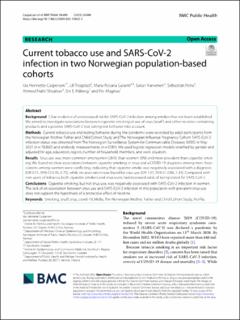| dc.description.abstract | Background Clear evidence of an increased risk for SARS-CoV-2 infection among smokers has not been established. We aimed to investigate associations between cigarette smoking or use of snus (snuff) and other nicotine-containing products and a positive SARS-CoV-2 test, taking test behavior into account. Methods Current tobacco use and testing behavior during the pandemic were recorded by adult participants from the Norwegian Mother, Father and Child Cohort Study and The Norwegian Influenza Pregnancy Cohort. SARS-CoV-2 infection status was obtained from The Norwegian Surveillance System for Communicable Diseases (MSIS) in May 2021 (n = 78,860) and antibody measurements (n = 5581). We used logistic regression models stratified by gender and adjusted for age, education, region, number of household members, and work situation. Results Snus use was more common among men (26%) than women (9%) and more prevalent than cigarette smoking. We found no clear associations between cigarette smoking or snus and a COVID-19 diagnosis among men. Associations among women were conflicting, indicating that cigarette smoke was negatively associated with a diagnosis (OR 0.51, 95% CI 0.35, 0.75), while no association was found for snus use (OR 1.07, 95% CI 0.86, 1.34). Compared with non-users of tobacco, both cigarette smokers and snus users had increased odds of being tested for SARS-CoV-2. Conclusions Cigarette smoking, but not snus use, was negatively associated with SARS-CoV-2 infection in women. The lack of an association between snus use and SARS-CoV-2 infection in this population with prevalent snus use does not support the hypothesis of a protective effect of nicotine. | |
